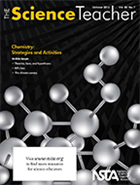Chemistry: Strategies and activities
By Mary Bigelow
Posted on 2013-10-06

October — The school year is well underway and it’s the month in which science teachers celebrate Mole Day (so who needs Halloween to have some fun?) It’s also the month for featured articles on chemistry.
Theories, Laws, and Hypotheses* should be required reading for all science teachers! Using the gas laws that many of us have in our curriculum, the authors address misconceptions that students and many adults have about the terms and how these terms are misused. The article has examples of laws and theories, and if you’re unsure about the terms, this is a good resource. [SciLinks: Gas Laws]
Many teachers use analogies to make abstract concepts more concrete, especially for students who are new to a concept. From Cars to Creatures describes how the use of analogies could be applied to concepts such as plate tectonics (comparing to fingernail growth), biological niches (comparing to types of cars), and stratigraphy (comparing to layers of a sandwich). The authors note that “asking students to describe aspects of the analog that are and are not accurate represenations of the target science topic…promotes higher-order thinking…” [SciLinks: Niches, Plate Tectonics, Stratigraphy]
What chemistry teacher among us has had students struggle with stoichiometry? NSTA’s chemistry list serve often has questions about this topic. Bill’s Box has a teacher-tested strategy for helping students with five types of stoichiometry problems, including examples. . The strategies use an analogy of building a tricycle and has suggestions for applying that concept to chemistry. [SciLinks: Stoichiometry]
Students often can plug in values and produce answers, but they don’t always understand what the process and the solutions actually mean. The authors of All Screwed Up* share an activity that can lead to a deeper understanding of chemistry concepts. Nuts and bolts from a hardware store are used to illustrate chemical kinetics and the basics of collision theory. The article includes teaching tips, examples of collected data, and suggestions for connecting the activity to the concepts. [SciLinks: Chemical Reactions]
As the authors of Antarctica’s Pine Island Glacier: A “Climate Canary”?* state: “Learning directly from data is powerful.” They describe a 2-3 day lesson in which students use real data to construct and use models to study the changes that are taking place in polar environments. [SciLinks: Polar Climate, Climate Change]
Check out the monthly columns for faculty meeting discussion-starters:
- Science 2.0: What keeps kids (and adults) engaged for hours? Designing Your Course Like a Video Game examines gaming features such as levels of challenges, quests, feedback, and the option to start over.
- The Green Room: Good Ozone, Bad Ozone addresses a misunderstanding that students may have about this atmospheric gas. [SciLinks: Ozone Depletion, Greenhouse Gases]
- New Teacher’s Toolbox: Is That the Teacher? has suggestions for setting boundaries and transitioning from college student to professional.
- Safer Science: Safety to the Wind looks at ventilation standards for science labs.
*Don’t forget to look at the Connections for this issue (October 2013). Even if the article does not quite fit with your lesson agenda, this resource has ideas for handouts, background information sheets, data sheets, rubrics, etc.
Disclaimer: The views expressed in this blog post are those of the author(s) and do not necessarily reflect the official position of the National Science Teaching Association (NSTA).


